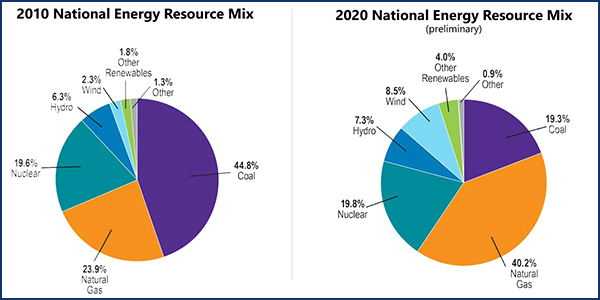The Edison Electric Institute is skeptical about the industry’s ability to meet the Biden administration’s goal of carbon-free electricity by 2035, insisting natural gas generation will be needed for the foreseeable future.
The transition to wind and solar backed by energy storage in just 15 years would be an extremely difficult goal, EEI’s President Tom Kuhn said during its annual Wall Street briefing Wednesday. “I think the 2035 date was a campaign initiative and would be an incredibly difficult situation to handle for most of the companies in the industry,” he said.
Instead, EEI says its investor-owned utility members are “collectively … on a path” to cut their carbon emissions by at least 80% by 2050 from 2005 levels.
The association’s top executives said although its members strongly advocate renewable energy, the rollout of electric vehicles and rejoining the Paris climate accords, meeting climate goals will require a massive expansion of the transmission grid, including electronic control systems still being developed and federal investments.
EEI’s presentation highlighted changes in the generation mix (“nearly 40% carbon-free”), which it said had resulted in the lowest level of CO2 emissions in 30 years.
Even if an expanded grid eliminates bottlenecks that impede delivery of renewables to load centers, EEI said gas-fired power plants and nuclear energy must remain in the generation mix. The nation’s 94 nuclear reactors produce nearly 20% of electricity and 50% of carbon-free power it said. The group said it supports “strong and cost-effective” federal regulations to reduce methane emissions throughout the natural gas supply chain.
Brian Wolff, vice president of public policy, noted that EEI has partnered with environmental groups to figure out the mix of sophisticated technologies that will be necessary to squeeze the last 20% of carbon out of the industry. In 2018, EEI and the NRDC unveiled 21 policy recommendations and made it clear that it would be expensive. And funding continues to be an issue.
“While we did a down payment on those technologies in the energy bill that passed in the lame duck session [of Congress] last year, we are really looking now to set the stage for the budget coming up that Congress will be dealing with as well as the administration putting forth their own budget to make sure [there are] appropriate levels of investments in these technologies,” Wolff said. (See Wind, Solar, EE, CO2 Storage Win Tax Breaks.)
EEI’s “carbon-free technology initiative” is focusing on five areas:
- advanced, dispatchable renewables (e.g., superhot deep geothermal) and advanced power electronics;
- zero-carbon fuels, such as hydrogen or ammonia, “from a variety of sources”;
- advanced nuclear energy (fission and fusion);
- carbon capture, utilization and sequestration, especially for natural gas facilities; and
- advanced demand efficiency and long-duration storage.
Phil Moeller, vice president for business operations, said the industry has invested more than $1 trillion since 2010 to build smarter energy infrastructure and to integrate new generation. “These investments continue to be central to our vision of a cleaner, smarter, strong energy future,” he said, noting 75% of U.S. households now have smart meters.
But the leap to the kind of integrated national grid the industry envisions will need a raft of new public policies, he said. Some of these policies are certain to encounter pushback at the local level.
“We are focused on advocating for public policies that enable us to get critical transmission and grid infrastructure built more quickly,” he said. “The transmission system is key to increasing the integration of clean energy. It enhances the resiliency of the grid, powers electric transportation and facilitates the adoption of a broad array of smart technologies.”
Richard McMahon, vice president for energy supply and finance, warned that the industry’s plans could be hurt by federal tax increases. The Biden administration has signaled it wants to raise the current 21% corporate tax rate to 28%.






